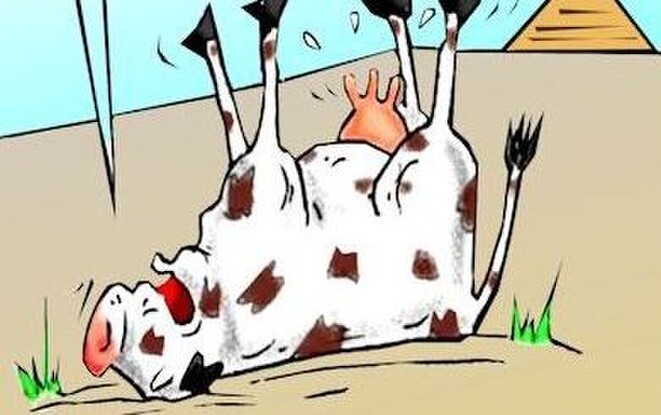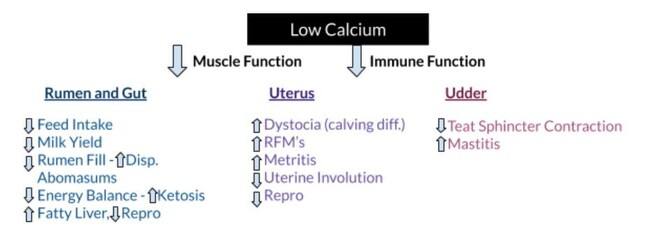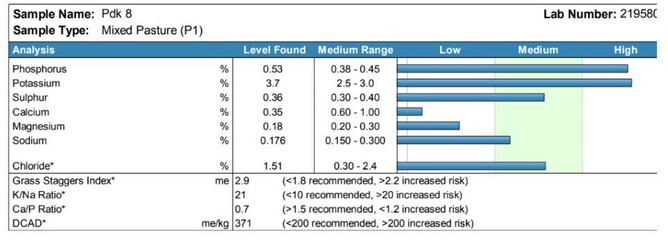Springer Cow Transition Management - it’s just around the corner. In winter 2018 we hosted the Upper Cow Roadshow - with guest speaker, international expert on the transition science of dairy cows- Peter DeGaris. The ‘Upper Cow’ phrase never caught on but it remains very relevant.
The best way to treat downer cows- is to prevent them from happening in the first place - hence ‘upper cows’. There is a brief outline below, detailing what a typical Southland farm did last season (herd of 800 cows) that went from treating up to 80 down cows one spring -to only treating 2 down cows last spring!!!
The ‘Why’- Let’s first appreciate how far reaching low calcium in a cow can be. All muscles require calcium to function normally, all bodily functions are impaired when calcium levels are less than adequate. As well as muscle function, their immune system also uses calcium in it’s defense against infection and disease at calving time.
The ‘What’ - What is your number? For every down cow there are up to 5-10 other cows in your herd negatively impacted by low calcium. 20x down cows treated, multiplied by 7 = 140 cows at risk of all the problems in the diagram above. Is this motivation to try something new?
The ‘How’ - Identify when your down cows are occurring, what they are deficient in and discuss with your KeyVet what can be done to prevent them. It might not just be a calcium issue - energy and magnesium imbalances are also commonly implicated. A cow’s RISK of milk fever is related to:
- Age and milk production
- Calcium
- Magnesium
- Phosphorus
- Number of days exposed to their pre-calving diet
- The DCAD of that diet (Dietary Cation Anion Difference).
Case Study Farm:
The 800 cow farm feeds a relatively typical winter diet of fodder beet, baleage and hay, then the springers go onto grass, silage and straw. Once calved, the cows have access to grass, silage and in-shed feeding. Over the past few seasons this farmer and farm team grew tired of the stress and negative impacts of treating ‘too many’ down cows (up to 80 in one season). The down cows consisted of milk fever within 24-48 hours of calving and grass staggers randomly in any cows.
Step 1: They assessed the cows ‘transition’ or springer diet.
- Feed analysis was done on the grass paddocks and silage. Feed analysis helps to gain important information on all 4x of the ‘unknown’ risk factors listed above - 2) Calcium, 3) Magnesium, 4) Phosphorus and 6) DCAD.
See below 1x of their grass paddock feed analysis results:
- The paddock pictured above was easily the highest risk for causing down cows (see it’s high DCAD level - 371, and it’s low calcium and magnesium levels). Of the potential springer paddocks tested, this specific paddock was allocated to the Heifers to ‘spring’ in. This avoided grazing the higher risk (older and high producing) cows in it.
- There was too much silage being fed to the springers- so they decreased the daily silage ration, and found an alternative feed to replace it with (sometimes easier said than done!) - in this case it was replaced by 2kg of straw.
But despite picking the ‘best’ of the potential springer paddocks, decreasing the silage, increasing the straw - there were still deficits in risk factors 2), 3) and 6) - calcium, magnesium and DCAD.
Step 3: They added ‘Transition Salts’ to the springer diet - to further manage the calcium, magnesium and DCAD needs.- A dose of 250g to 350g of Agvance Transition Salts were needed per cow per day in the springer mob - depending on the ratio of grass to silage being fed.
- Transition Salts are the best tool available for controlling DCAD in grass based dairy farming. The salts also took care of the magnesium and calcium requirements for the springers.
- This farm fed out and mixed the Transition Salts into their silage, via their mixer wagon.
- Many farms don’t have the luxury of a mixer wagon - but there are good success stories from those who are layering the salts through the load of silage, or even just sprinkling them over feed multiple times a day.
- A specific mineral dosing bin was installed - alongside their in-shed feed system. Through this a fully balanced mineral prill was fed (Optiprill Performance) - accurately - irrespective of the amount of grain being fed. This system adds the minerals along the feed line - so feed levels can be altered, without affecting the dose of the minerals.
- This was used throughout the whole season for mineral supplementation - and made giving calcium and magnesium easy, efficient and most important- effective (especially compared to dusting!).
In summary - this was a complete success. However - there are no 2x seasons the same, there are no 2x farms the same and as pasture analysis is showing - not even 2x grass paddocks the same! Talk to your KeyVet regarding your farm’s specific down cow issues, and get prepared. The calcium bolus - CalproBolus- that Georgette’s article refers to, could be another useful tool to add to your arsenal. Transition Salts target herd level prevention, and the boluses are a method of prevention at the cow level - good for those extra high risk individuals. Making a plan now is time well spent. It’s a hard road finding the time during spring - especially if you have a couple of down cows to treat in a day.
- Claire Hunter



